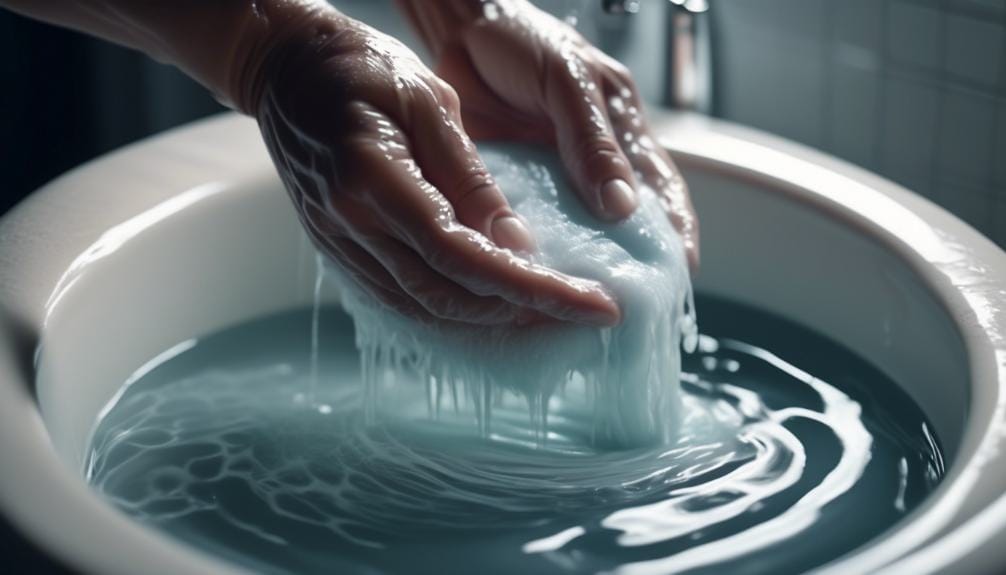How to Wash Duvet by Hand: Gentle Cleaning Techniques
When it comes to washing your duvet by hand, it’s like handling a delicate flower – it requires precision and care to maintain its beauty and softness.
You may be surprised to learn that hand washing your duvet can be a simple and effective way to keep it clean and fresh, without the wear and tear of a machine.
From preparing the right cleaning solution to the gentle agitating technique, there are steps to follow that will ensure your duvet is thoroughly cleaned without losing its loft and comfort.
So, let’s explore the gentle cleaning techniques that will leave your duvet feeling as good as new.
Key Takeaways
- Carefully inspect the care instructions on the duvet tag before washing
- Mend any holes or tears before washing the duvet
- Pre-treat stains with lukewarm water and a gentle stain remover
- Soak the duvet in warm, soapy water and gently agitate it to loosen dirt, stains, and odors
Essential Considerations Before Washing

Before washing your duvet, it’s important to carefully inspect the care instructions on the tag to ensure you follow the specific recommendations for cleaning.
Mend any holes or tears in the duvet before proceeding with washing.
Pre-treat stains with lukewarm water and a gentle stain remover, and spot-clean set-in stains with a clean toothbrush. Scrub any stains gently before continuing with the wash routine.
Always check the care label for any special instructions or restrictions on washing by hand.
Use a mild detergent suitable for hand washing delicate fabrics.
Be mindful of the duvet’s filling material, as some may require specific care.
Necessary Materials for Hand Washing

To hand wash your duvet, gather the necessary materials:
- A large laundry tub or bathtub
- Mild powdered detergent
- Clean towels
- Wool dryer balls or clean tennis balls for drying
The large laundry tub or bathtub should be large enough to comfortably soak the duvet. When choosing a mild powdered detergent, ensure it’s suitable for delicate fabrics to avoid damaging the duvet filling.
Clean towels are essential for spot cleaning and rinsing during the hand-washing process. Wool dryer balls or clean tennis balls help fluff the duvet while it dries.
If hand washing isn’t feasible, consider using a front-loading, large-capacity washing machine and dryer.
These necessary materials will enable you to follow gentle cleaning techniques and hand-wash your duvet with care.
Proper Preparing and Soaking Technique

When preparing to hand wash your duvet, ensure that you have dissolved one-third to half the usual amount of mild powdered detergent in warm water, as this will aid in effectively loosening dirt and stains during the soaking process.
After immersing the duvet in the soapy water, allow it to soak for a few minutes to ensure that the detergent penetrates and loosens any dirt, stains, and odors.
Gently agitate the duvet in small sections during soaking to ensure thorough cleaning of the filling.
Once the soaking process is complete, rinse the duvet with clean, warm water to remove all soap residue and prepare it for drying.
Proper soaking technique is essential as it helps to loosen dirt, stains, and odors, making the cleaning process more effective.
Thorough Rinsing Process

Thoroughly rinsing your duvet with clean, warm water after hand washing is crucial to ensure the removal of all soap residue, promoting a fresh and clean outcome for your bedding. To achieve this, fill a large capacity washer or bathtub with clean, warm water and fully submerge the duvet, gently pressing the water through the filling to flush away any excess soap. Then, carefully drain the water and refill the washer or bathtub with fresh water, repeating the process until no soap suds are visible. Ensure the duvet is fully rinsed to prevent any residue from causing skin irritation or damaging the fabric. This thorough rinsing process will result in a clean and fresh duvet for a comfortable night’s sleep.
| Benefits | Outcome |
|---|---|
| Removes all soap residue | Fresh and clean bedding |
| Prevents skin irritation and damage | Comfortable and safe sleeping environment |
Gentle Drying Methods

For gentle drying methods, consider using a front-loading dryer with adequate space for the duvet to ensure even and efficient drying. When drying the duvet, use the low heat or air fluff setting to prevent any damage to the fabric or filling.
Additionally, adding wool dryer balls or clean tennis balls can help evenly distribute the filling and speed up the drying process.
After the drying cycle, check the duvet’s dryness, and if necessary, run an additional spin cycle to remove any remaining moisture. Once dried, allow the duvet to fully air out before placing it back on the bed to ensure that it’s completely dry and fresh for use.
Frequently Asked Questions
How Do You Wash a Duvet With Your Hands?
To wash a duvet by hand, immerse it in warm water with mild detergent and gently agitate the filling. Then, rinse thoroughly and gently squeeze out excess water. Finally, air dry or use the low heat setting in the dryer with wool or tennis balls.
How Do You Wash a Duvet Without a Washing Machine?
To wash a duvet without a washing machine, start by spot-treating stains with a gentle stain remover. Then, soak the duvet in a tub of lukewarm water and mild detergent. Gently agitate the duvet, rinse thoroughly, and air dry.
Can You Wash a Duvet on Delicate?
Yes, you can wash a duvet on delicate. Use a large-capacity, front-loading washing machine and mild detergent. Select a gentle wash cycle with cold or lukewarm water. Ensure it’s completely dry before storing.
What Is the Best Way to Clean a Duvet?
To clean a duvet, follow the care instructions on the tag. Mend any tears, pre-treat stains, and use a front-loading machine with gentle detergent. Consider hand-washing in a large tub with mild detergent for a gentle clean.
Conclusion
Now that you have carefully hand washed your duvet, make sure to air dry it completely before putting it back on your bed.
Remember to check the care instructions and mend any tears before washing, and always use a gentle detergent to avoid damaging the fabric.
With these gentle cleaning techniques, your duvet will be fresh and clean, ready for cozy nights of sleep.
